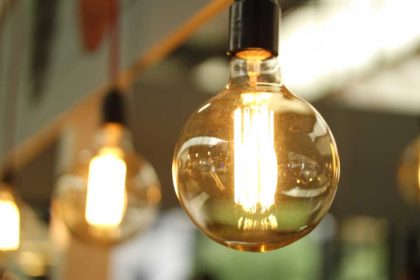
Energy costs are increasing this winter, as home heating costs will rise by another 28% in 2022-2033, according to the U.S. Energy Information Administration. While consumers can’t control big-picture issues like energy capacity and natural gas demand, they can control the amount of cash they spend on monthly energy bills. We have seven simple steps to help you reduce the amount you spend on water, heating, and electricity bills.
1. Make your home smarter.
Automatic systems conserve energy when you don’t need it. Consider adding a motion light to your front door or driveway so it automatically turns on when you or a guest pulls up and turns off when there’s no one around. Exterior motion lights are also great for deterring unwanted guests!
Invest in a smart programmable thermostat, such as a Nest or Ecobee, which will allow you to set a recurring schedule and reduce energy consumption while everyone is out of the house. You’ll have a lot more control over your heating and cooling system with these products and over time they will help you make adjustments to your schedule to keep your heating and cooling systems running more efficiently.
2. Make sure you’re on the lowest rate plan.
Many households don’t realize they aren’t on the cheapest electricity rate plan offered by their utility company and are needlessly paying extra every month. This easy fix won’t cost you any money, just a bit of your time.
Reach out to your utility company and ask about the different rate plan options available to you and then evaluate which plan best suits your usage patterns. For example, you could find a Time of Use (ToU) rate plan that charges a high rate from 9-5, but a much lower rate for the rest of the day. This plan is perfect for those who are out of the house during working hours.
On a similar note, ToU plans that offer low rates overnight are a great option for those who have an electric car to charge, or smart appliances that can be set to run at night. Once you find the perfect plan for you, all you have to do is call your electric company and ask them to switch the plans – consider this to be a low-hanging fruit of energy cost savings.
3. Focus on the biggest energy users – heating and cooling.
The biggest energy consumers in your home are your heating and cooling systems. If you can reduce the electricity used for both, you’ll make a huge dent in your overall energy spending. The easiest way to do this is upgrading your current heating and cooling systems to more efficient models. According to Energy.gov, if your air conditioning is 10 years old, you can save between 20-40% in energy costs by switching to a newer model.
The key to upgrading your older equipment is making sure you’re purchasing an efficient model by checking the SEER rating or by looking for an Energy Star certified model. It’s also very important to make sure heating and cooling systems are properly installed and maintained to mitigate leakages that make your systems work harder than they need to be.
4. Stop messing with the temperature.
A few easy and quick ways to save some cash is to lower the base temperature on your water heater to 120 degrees, wash your clothes with a cold or warm water cycle, and stop using the heated drying cycle on your dishwasher.
Also consider programming your thermostat to a few degrees (lower in the winter and higher in the summer) while the house is empty during the day or while everyone is sleeping. If you don’t have a programmable thermostat, consider having one installed, set a programmable schedule and stick with it!
5. Install a tank-less water heater.
Don’t let the upfront cost of a tankless water heater scare you – they save an average of $100 a year over a traditional water heater! They typically have a more compact design, a longer lifespan, and better warranties than a traditional water heater too. It’s definitely worth the long term investment!
6. Reduce energy losses and leakages.
Conducting a home energy audit is a great way to find out where exactly you’re losing money. Some of the biggest culprits include poorly-insulated doors and windows, an uninsulated attic, air leaks or drafts, or inefficient lighting. Here are so common fixes:
- Fix Insulation: anywhere your home lacks good insulation, work with a contractor to assess and upgrade. Attics, basements, crawl spaces and sometimes walls can be common spots to upgrade.
- Weatherize: Your exterior doors and windows can be a huge source of heating and cooling loss. Check the seals on your doors and windows to make sure they’re properly sealing your home.
- Update appliances and electronics: Only purchase products that have excellent efficiency; they may cost a bit more upfront, but you will save on energy costs in the long run. Look for appliances with an Energy Star Label or a sticker that tells you how much it costs to run per year.
- Replace Lighting: Replace your old incandescent bulbs with efficient LED light bulbs, insulated can lights, and more efficient fixtures.
7. Change your habits.
Changing these simple daily habits can help lower your energy usage and put money back into your pocket:
- Run ceiling fans instead of the air conditioner
- Wash small loads of dishes by hand instead of using the dishwasher
- Always turn off lights in unoccupied rooms
- Wash your clothes in cold water
- Turn down your hot water heater
- Turn down your thermostat and use blankets when relaxing
- Unplug appliances when not in use
These seven, simple steps can help reduce the amount you spend on water, heating, and electricity bills; helping you save up for that kitchen remodel you’ve been dreaming of!